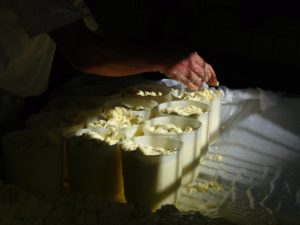
Editor’s Note: This sponsored column is written by Katie Carter, cheesemonger at Arrowine (4508 Lee Highway)
World famous Swiss affineur Rolf Beeler, the great Swiss cheese importer Caroline Hostettler, and the author of Fromages Suisses, Dominik Flammer, all say Willi Schmid is the best cheesemaker in Switzerland. But I needed to understand for myself, what makes him so great? After spending two weeks with Willi Schmid and his crew at Städtlichäsi creamery in Lichtensteig, Switzerland, I came to understand what makes this cheesemaker and his cheese so special.
Willi Schmid, a lifetime resident of the Toggenburg region of Switzerland, is a master at listening to the voice of the land and translating that voice into distinctive and ever-evolving artisanal cheese. His unprecedented creativity and a very broad knowledge of the science of cheese makes him one of the world’s leading cheesemakers. He has truly taken the craft of cheesemaking to a new level.
 Simply put, Willi Schmid combines innovation with tradition to create unique cheeses of the highest quality that also happen to be Swiss. But there is nothing simple about how Willi accomplishes this. His understanding of the milk of his region is unsurpassed and he knows how to transform a specific day’s milk into an appropriate cheese expression. He has largely broken free of the classic Swiss cheese types and creates many styles, from goat’s milk blues to pine bark-wrapped washed rinds; about 30 different kinds in all. Though some of these styles are new to Switzerland, they are completely terroir driven; conveying the personality of each milk, the season, and the land.
Simply put, Willi Schmid combines innovation with tradition to create unique cheeses of the highest quality that also happen to be Swiss. But there is nothing simple about how Willi accomplishes this. His understanding of the milk of his region is unsurpassed and he knows how to transform a specific day’s milk into an appropriate cheese expression. He has largely broken free of the classic Swiss cheese types and creates many styles, from goat’s milk blues to pine bark-wrapped washed rinds; about 30 different kinds in all. Though some of these styles are new to Switzerland, they are completely terroir driven; conveying the personality of each milk, the season, and the land.
Willi Schmid thinks and operates and on a very intense level. In the creamery, he moves fast and in an exacting manner, while juggling three to five recipes at one time in his head, using only his nose and palate, a thermometer, and 28 years of experience to guide him.
Before 9:00 a.m. this man has received milk from a few local farmers, driven to get local milk, driven the whey to local pigs, and made not just one great batch of cheese, but about four different kinds. They are all made with raw or thermised (gently pasteurized) milk from Brown Swiss and Jersey cows, goats, sheep, and even four beautiful water buffalo. After using very unique and innovative techniques in the creamery, the bare minimum is done in the caves in order to let the milk shine. There is little blue mold or white bloom and no heavy washed rinds.
For Willi, the raw materials are absolutely the most important element of cheesemaking. He lives by the philosophy that only great cheese can come from great milk. Working with the area’s best farmers, he only uses milk of the highest quality. Willi examines the milk each morning by tasting it and only decides then which cheese recipe will best express the milk. He is very aware of the seasonal changes to the milk and isn’t afraid to adjust his production schedule because of these changes.
Just like the different wine varietals, each breed’s milk tastes different and, therefore, some of his cheeses are only made with a certain breed’s milk, and often only a particular herd of that breed. This kind of attention to detail reminds me of great winemakers but, in the world of cheese, this practice is almost unheard of.
I credit my experience and education at Arrowine for understanding the importance of raw materials and the effects of manipulation in regard to wine and cheese. My bosses Doug Rosen and Shemsedin Hassen consistently select wines that are an honest expression of the grape and land it grows on. I have heard them say over and over that, “Great wine is made in the vineyards.” It is not made with technology and especially not made by just creating a wine for the masses or the reviewers.
Similarly, the very best cheeses are an honest expression of their breed of animal, it’s milk, and the land it eats from. They are not heavily manipulated in the creamery or aging cellars. Great cheese is made in the fields, but it is also made by great farmers and cheesemakers.
Flammer, the author, said to me: “There is always tradition behind innovation.” This is what makes Willi Schmid so great — he has mastered the classics during his 28 year career and yet has risen to a higher level of artistry that we can all admire and enjoy.
Katie Carter is Arlington’s first and only ACS Certified Cheese Professional. She has worked in the cheese industry for ten years as a cheesemaker, cheesemonger, and educator. She can be found on Twitter @AfinaCheese. The views and opinions expressed in the column are those of the author and do not necessarily reflect the views of ARLnow.com.







